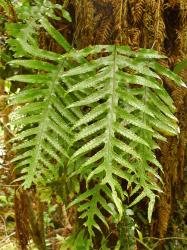- = Dendroconche Copel., Philipp. J. Sci., C 6: 91 (1911)
- = Zealandia Testo & A.R.Field, Syst. Bot. 44: 749 (2019)
Epiphytic, rupestral or terrestrial ferns. Rhizomes long-creeping (NZ) or short-creeping (not NZ), terete or occasionally dorsiventrally flattened, cavities lacking (NZ) or with hollow spaces inside or below, often associated with ants (not NZ), lacking sclerenchyma strands, pruinose or not, scaly (NZ) or without scales, or nearly so and spiny (not NZ), glandular hairs absent (NZ) or rarely present (not NZ). Rhizome scales peltate, clathrate, narrowly ovate to orbicular, squarrose or appressed. Fronds monomorphic or dimorphic, articulated to short stalks (phyllopodia) at intervals along the rhizome. Laminae undivided, variously lobed or deeply 1-pinnatifid, or rarely 2-pinnatifid, herbaceous to coriaceous, virtually glabrous. Veins reticulate, in type 5a or 5b pattern (Nooteboom 1997), usually forming 1–3 series of areoles between costa and lobe margin, lacking main lateral veins that extend in a ± continuous straight line from costa to near the margin; largest areoles adjacent to costa, with free included veinlets, ending in hydathodes. Sori round or slightly elongate (NZ) or rarely the sporangia acrostichoid (not NZ), superficial or impressed into the lamina and bulging on adaxial surface, arranged in one row either side of costa (NZ) or in more than one row, or scattered over the lamina surface, or deeply immersed in marginal semi-circular projections (not NZ), not confluent with age, occurring throughout the lamina; paraphyses absent (NZ) or sometimes present as simple uniseriate hairs (not NZ); exindusiate. Spores monolete, bilaterally symmetrical, finely rugulate to tuberculate, rarely with twisted strands around the spore (not NZ).
A genus of 24 species (Perrie et al. 2021).
As outlined under the family treatment, an expanded Lecanopteris is recognised here to include species previously treated in Lecanopteris sens. str., Dendroconche and Zealandia (Perrie et al. 2021).
| 1 | Rhizomes usually <4 mm diameter; laminae dull green, herbaceous, exuding musky aroma when fresh, alate for 10–150 mm below lowest pinna lobe | scandens |
| Rhizomes usually >4 mm diameter; laminae bright green, coriaceous, lacking musky aroma when fresh, alate for 5–40 mm below lowest pinna lobe | 2 | |
| 2 | Rhizome scales appressed, blackish-brown; laminae highly dimorphic, from undivided to deeply 1-pinnatifid; hydathodes prominent on upper surface | pustulata |
| Rhizome scales squarrose, orange-brown; laminae usually monomorphic, deeply 1-pinnatifid; hydathodes inconspicuous on upper surface | novae-zealandiae |
Most species of Lecanopteris occur in tropical Malesia (peninsular Malaysia, Singapore, Borneo, Philippines, Indonesia, Papua New Guinea) but a few extend into south temperate regions; five in Australia and three in New Caledonia. One species endemic and two indigenous to New Zealand.
| Category | Number |
|---|---|
| Indigenous (Endemic) | 1 |
| Indigenous (Non-endemic) | 2 |
| Total | 3 |
n = 36, 37 (Hennipman et al. 1990).




